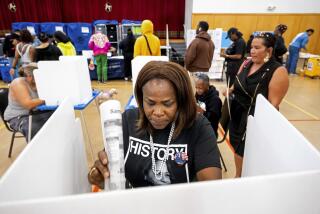Some States Are More Equal Than Others
- Share via
Al Gore may well be wondering what happened to 4% of his votes. George W. Bush isn’t likely asking any questions about his 5% surplus. What is going on? Election fraud? Corruption? No, this election will likely turn on a political deal made in Philadelphia, a deal made in 1787.
Gore faces the possibility of losing in the electoral college despite triumphing in the popular vote. This would be only the second time in our nation’s history such an anomaly has occurred.
How could this happen? The answer, superficially at least, lies in the electoral college system we use to elect our president. Votes are tallied by state, with the winner of each state (in most cases) taking the entire state’s allotment of electors. That system alone could result in the popular/electoral vote mismatch. But the problem is compounded by the manner in which electoral college votes are apportioned. Each state and the District of Columbia receive electoral votes according to their representation in both houses of Congress. So, for example, Illinois, which has 20 members in the House and two senators, has 22 electoral votes. Thus the composition of the electoral college bears the strong mark of the celebrated “Connecticut compromise.”
As attentive civics students will recall, the Connecticut compromise resolved disagreement between representatives at the Constitutional Convention in Philadelphia. Delegates from small-population states wanted congressional representation to be equal for each state, while delegates from large-population states wanted congressional representation proportional to population. The compromise split the difference by having two houses of Congress, with one house based on the “small state” system and one house based on the “large state” system. The compromise helped gain the Constitution the support necessary for ratification but it also institutionalized disproportionate representation in the Senate, a problem compounded by the addition of several small-population states in the Rocky Mountain West. The consequence has been stalemate on several issues, such as the level of fees charged by the federal government for grazing and mineral rights.
Today we see the more profound consequence of the Connecticut compromise in the context of presidential elections. If representation in the electoral college were based only on population, that is, if the electoral college paralleled the House, Gore would win the presidential election (assuming Bush wins Florida and Gore wins Oregon). But this is not the case, of course.
Instead, several small-population states have disproportionate influence in the presidential election. Wyoming, for example, has 0.18% of the U.S. population and 0.93% of the votes in the electoral college. These numbers suggest that Wyoming enjoys 412% more representation in the electoral college than it would under a proportional system. Other Bush states that are overrepresented include Alaska (152%), North Dakota (117%) and South Dakota (99%). Gore benefits in some cases as well. Vermont (146%), the District of Columbia (128%) and Delaware (108%) are all overrepresented in Gore’s favor.
In the aggregate, however, Bush benefited considerably while Gore suffered. Overall, Bush received 5% more votes in the electoral college than he would have if electoral votes were proportional to population. In contrast, Gore received 4% fewer electoral votes than he would have under a proportional system. This can be explained by Gore’s success in large population states that are underrepresented in the electoral college. For example, California has 12% of the U.S. population but only 10% of the electoral vote (or 16% fewer electoral votes than it would if votes were determined by population).
Perhaps Gore will squeak out a narrow victory in Florida, thus capturing the White House. If not, Bush will ascend to the presidency due in part to an electoral system that awards inordinate influence to some citizens based on accidents of geography and political history. It is time to rethink a system that is designed to satisfy the political exigencies of the late 18th century. It may be too late for Gore, but is not too late to award each citizen an equally weighted voice in the presidential election process.
More to Read
Get the L.A. Times Politics newsletter
Deeply reported insights into legislation, politics and policy from Sacramento, Washington and beyond. In your inbox twice per week.
You may occasionally receive promotional content from the Los Angeles Times.







